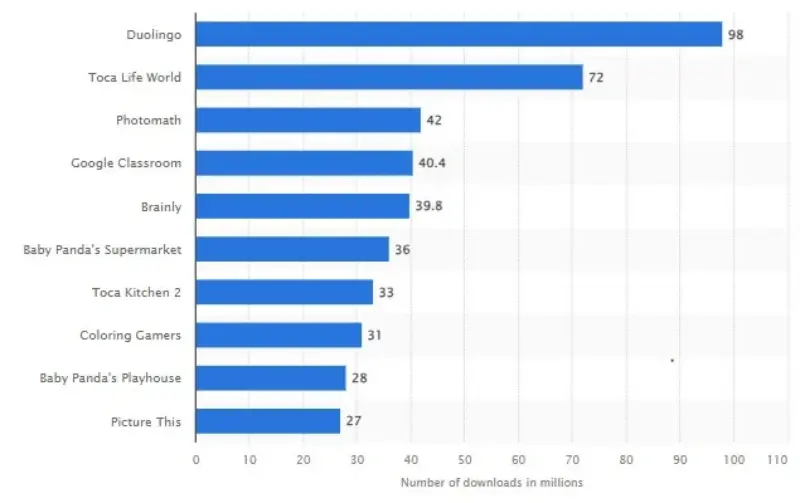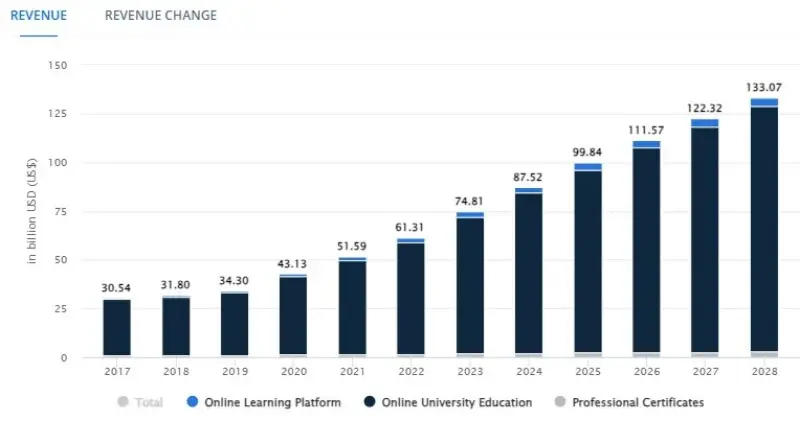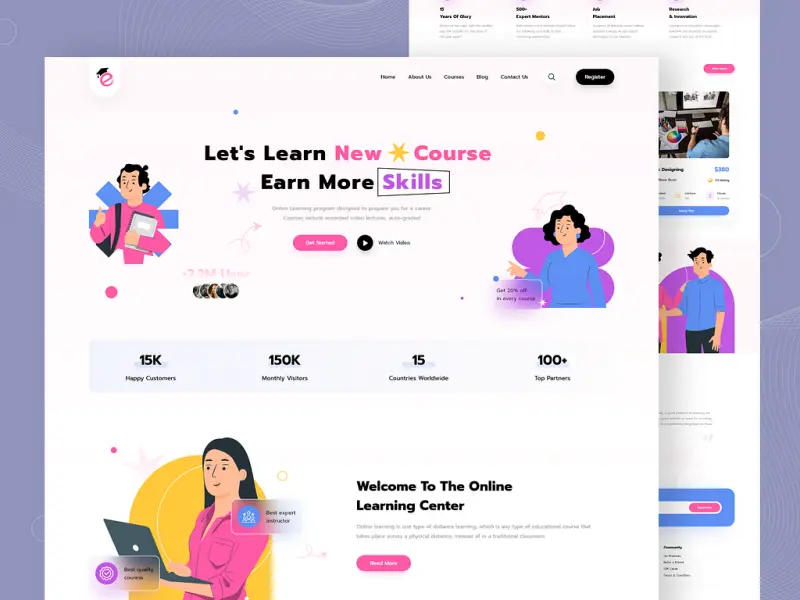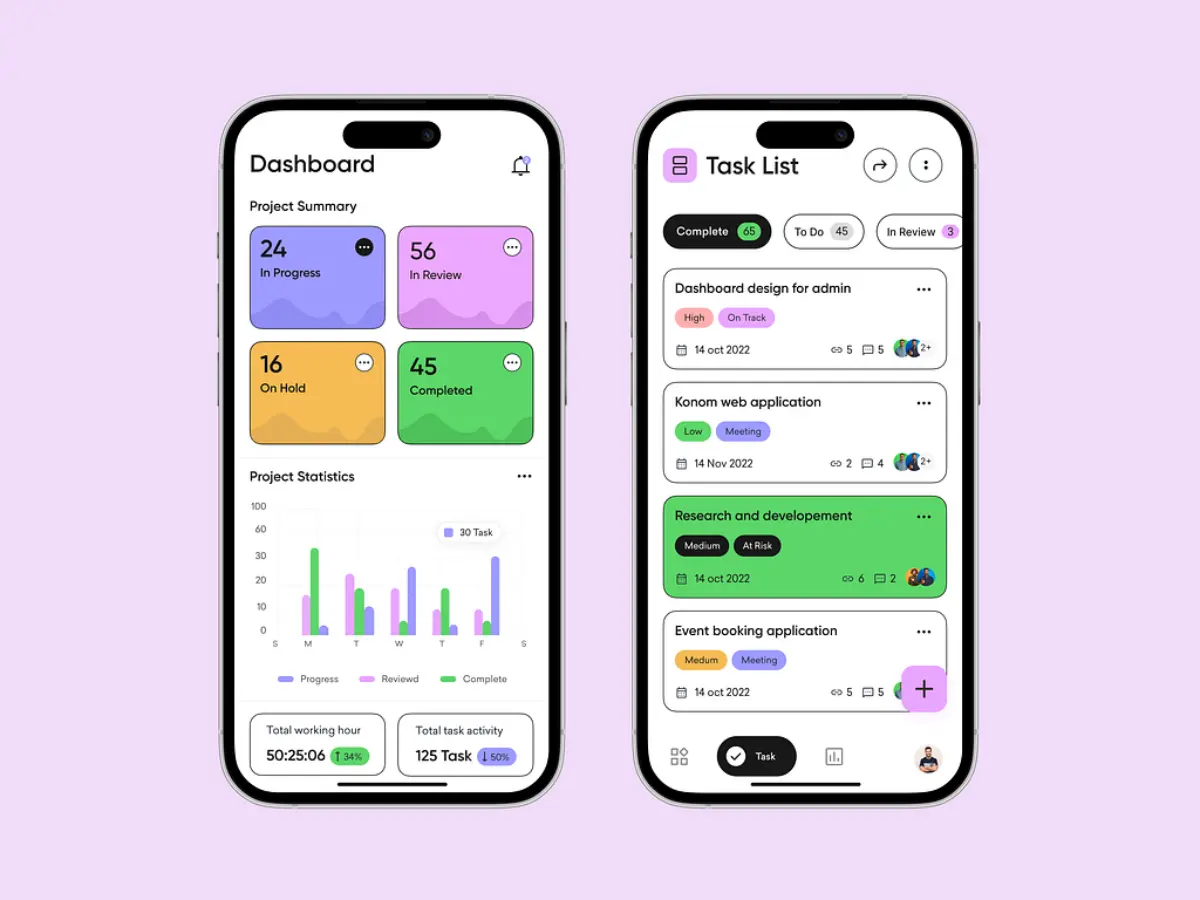Breaking Down the Educational App Development Cost: What You Need to Know
- TECHVIFY Team
- 0 Comments
In recent years, we’ve all witnessed a significant transition from traditional offline learning to digital platforms. This transformation has reshaped the education industry, leading to new trends and challenges. One such challenge is the declining interest in reading and learning through books due to increased screen time. Given this shift, why not make education engaging and enjoyable through a mobile application?
If you’re uncertain about the investment required to develop an educational app, you’re not alone. Cost is indeed a critical factor when building any app, especially in the well-established education sector. Estimating the budget for such projects can often seem complex and overwhelming.
Depending on various factors, the cost to create an educational app typically ranges from $25,000 to $350,000. However, a comprehensive cost guide can be invaluable in navigating this challenge effectively. Keep reading to explore the types and factors influencing educational app development cost.
I. Understanding the EdTech Market: Trends and Costs
How much does it cost to develop an EdTech app? While the answer can be summarized in a simple cost range, it’s essential to delve deeper into the emerging trends shaping both the education and educational app industries.
The COVID-19 pandemic catalyzed a massive technological transformation within the education sector. According to research by Holon IQ, global EdTech spending will skyrocket to $404 billion by 2025. The integration of technology into education is no longer a luxury—it’s a necessity. From private firms to government organizations, various stakeholders are developing educational software to enhance learning experiences.
The pandemic highlighted the urgent need for digital tools. Educators began relying on technology to communicate with students, monitor their progress, and deliver course materials. This period also sparked an unprecedented demand for tech-driven solutions across the education sector.
The Growth of Online Education
Statista Report
The online education industry has experienced exponential growth, and it’s projected to continue expanding in the coming years. Let’s explore some key statistics that underscore this trend:
- Revenue in the online education market is expected to surge by $87.51 billion by 2024.
- The number of users in the online education space is predicted to reach 82.7 million by 2028.
Key Educational App Market Insights
Educational app development Market
The global educational app market has seen remarkable growth, driven by the growing need for easy-to-use and readily available learning solutions. Here are some notable statistics:
- Duolingo topped the charts as the most downloaded learning app in 2022, with 98 million downloads worldwide.
- The global educational app market was valued at $43.83 billion in 2022.
- 23% of U.S. consumers spent on mobile educational apps between January and August 2022.
- In 2023, ABCmouse, a subscription-based app for children, was the most downloaded educational app in the U.S., with 2 million downloads.
More articles from our website:
II. Different Types of Educational Apps in the Market
The educational app industry offers a wide variety of solutions, custom-built to address the unique requirements of different learning stages and requirements. Let’s take a closer look at the most popular types of educational apps currently active in the market.
Language Learning Apps
Language-learning applications are created to assist users in mastering new languages through interactive lessons, exercises, and assessments. These apps cover everything from basic grammar to advanced vocabulary, making language learning fun and engaging. Many apps also offer opportunities to practice speaking, writing, and listening in real-world contexts, making them highly effective for language acquisition.
Examples: Duolingo, Babbel, Rosetta Stone
Classroom Education Apps
Classroom education apps turn your device into a virtual classroom, enabling teachers and students to communicate seamlessly. These apps facilitate the sharing of study materials, assignment tracking, and grading while improving the overall organization and interactivity of classroom learning. They are invaluable for both in-person and remote learning scenarios.
Examples: Edmodo, Kahoot, Google Classroom
Online Course Apps
Have you ever wanted to learn something new, like photography, coding, or even cooking? Online course apps offer a vast array of courses across various subjects, allowing users to learn at their own pace. These apps typically feature video lectures, expert-created assignments, and assessments to help learners acquire new skills.
Examples: LinkedIn Learning, Udemy, Coursera
Educational app development cost
Exam Preparation Apps
These apps are particularly useful for learners getting ready for standardized tests such as the SAT, ACT, or professional certification tests. Exam prep apps provide practice questions, mock exams, and review tips to help users study efficiently and build confidence ahead of their exams.
Examples: BYJU’s, Khan Academy, Quizlet
Educational Apps for Kids
Educational apps designed for children make learning fun and interactive. These apps use colorful interfaces, engaging characters, and interactive games to teach young learners fundamental subjects like reading, writing, math, and science. Early learning is transformed into an enjoyable experience, fostering a love for education from a young age.
Examples: Toca Boca, ABCmouse, Endless Alphabet
III. Key Factors Influencing the Educational App Development Cost
Establishing the cost of developing an educational app depends on several important factors that directly impact the budget, performance, and user engagement. Below, we’ll explore these key factors in detail, specifically focusing on development cost estimates if you choose to build your app in Vietnam, where development costs are generally lower than in Western countries.
1. Technology Stack: The Foundation of Development Costs
The choice of technology stack is one of the most important decisions in app development—it directly impacts both the app’s performance and its cost. The selected languages, frontend, backend, and database technologies all contribute to the overall development expenditure.
Some technology platforms may involve higher initial costs, but they also offer future-proof solutions, ensuring that your app remains relevant and doesn’t become obsolete in the years to come.
| Technology Stack | Description | Cost Estimation |
|---|---|---|
| Frontend: React Native | Cross-platform framework for mobile app development using JavaScript and React. | $12,000 – $50,000 |
| Backend: Node.js (Express) | Server-side framework for building scalable, high-performance web applications using JavaScript. | |
| Database: MongoDB | NoSQL database is used to store flexible, schema-less documents. | |
| Frontend: Flutter | Cross-platform framework for mobile apps using Dart and Flutter. | $20,000 – $75,000 |
| Backend: Firebase | Cloud-hosted backend services for mobile and web applications. | |
| Database: Firestore | Scalable, NoSQL cloud database for syncing data in real-time. | |
| Frontend: Angular | Framework for building single-page web applications using TypeScript. | $50,000 – $120,000 |
| Backend: Django | High-level Python framework emphasizing rapid development and clean design. | |
| Database: PostgreSQL | Open-source relational database known for robustness and scalability. | |
| Frontend: Vue.js | Progressive JavaScript framework for building interactive user interfaces. | $150,000 – $300,000 |
| Backend: Ruby on Rails | Full-stack web framework using Ruby, known for rapid development. | |
| Database: MySQL | Popular open-source relational database management system. |
Selecting the appropriate technology stack is essential for your app’s success, so it’s essential to weigh the benefits of each technology carefully. Seek advice from professionals to ensure well-informed choices that meet your project’s long-term goals.
2. Complexity: More Features, More Development Effort
The complexity of your app is another major cost driver. The more advanced features and functionalities you incorporate, the higher the development cost. Complex features such as real-time chat, geolocation, and augmented reality (AR) can significantly raise both the time and resources needed to develop your app.
Below is a guide to help you assess the relationship between complexity and cost.
| Complexity Level | Description | Cost Estimation |
|---|---|---|
| Low Complexity | Basic features, minimal design, simple functionality | $5,000 – $25,000 |
| Medium Complexity | Moderate features, custom design, some third-party integrations | $25,000 – $100,000 |
| High Complexity | Advanced features, custom design, extensive integrations, and APIs | $100,000 – $500,000+ |
Planning your app’s feature set carefully is crucial to avoiding unnecessary complexity, which can increase both costs and development time.
3. Platform: Where Will Your App Thrive?
The platform on which you decide to release your app will significantly impact your development costs. Each platform—whether it’s web-based, iOS, Android, or cross-platform—has its own cost structure, which is influenced by the target audience and their preferences.
Here’s a breakdown of the development costs for different platforms:
| Platform | Description | Cost Estimation |
|---|---|---|
| Web | A web-based app accessible via browsers on both desktop and mobile devices. | $12,000 – $75,000 |
| iOS (Apple) | Native apps built specifically for iPhones and iPads, available on the Apple App Store. | $25,000 – $100,000 |
| Android | Native apps developed for Android devices, available on the Google Play Store. | $25,000 – $100,000 |
| Cross-Platform | Develop once and deploy across both iOS and Android using frameworks like React Native or Flutter. | $25,000 – $150,000 |
4. UI/UX Design: Enhancing User Experience
A well-designed user interface (UI) and seamless user experience (UX) are key to attracting and retaining users. A visually appealing design paired with intuitive navigation can significantly boost user engagement and loyalty, giving your app a competitive edge.
Here’s a look at how different levels of UI/UX design affect development costs:
| UI/UX Design Level | Description | Cost Estimation |
|---|---|---|
| Basic | Standard UI elements, simple layout, minimal graphics, and basic navigation. | $2,500 – $8,000 |
| Moderate | Custom UI elements, enhanced layout, improved graphics, and intuitive navigation. | $8,000 – $20,000 |
| Advanced | Highly customized UI, rich graphics, animations, and immersive user experiences. | $20,000 – $50,000 |
5. The Development Team: Expertise Matters
Your choice of a development team is one of the most important factors influencing both the cost and quality of your educational app. The skill level, location, and experience of the team will largely determine how efficiently your app is developed and whether it meets your business objectives.
Here’s a comparison of different development team options:
| Development Team | Description | Location | Cost Estimation |
|---|---|---|---|
| Freelancers | Individual developers or small teams working on a contract basis, offering flexibility but with varying quality. | Global | $10,000 – $50,000 |
| Boutique Agency | Small to medium-sized agencies offering personalized services and often delivering specialized expertise. | Regional | $25,000 – $100,000 |
| In-house Team | Hiring and managing an internal team, providing full control over the project and long-term continuity. | Local | $150,000 – $350,000+ |
Choosing the right development team will ensure that your project moves smoothly from ideation to launch while also offering flexibility in addressing unforeseen challenges.
Looking to Outsource Development?
Contact TECHVIFY, Vietnam’s Leading Offshore Software Development & Outsourcing Company, for a consultation and development services.
IV. Popular Educational Apps and Their Development Costs
Now that you have a clearer understanding of the different types of educational apps, let’s dive into the development costs associated with creating some of the most popular educational apps. Keep in mind that the exact cost depends on various factors, such as features, platform, and complexity. Moreover, the expense can fluctuate considerably depending on the geographical location of the development team. With its burgeoning tech industry, Vietnam offers more affordable development rates than Western countries, which we’ll highlight for each app.
Duolingo
Duolingo is a widely popular language-learning app that gamifies the learning experience with a user-friendly interface. Its mission is to make education fun, accessible, and free for everyone. Scientifically proven to be effective, Duolingo’s game-like exercises and interactive design contribute to its massive success.
- Estimated Development Cost (Western Countries): $15,000 to $150,000
- Estimated Development Cost (Vietnam): $10,000 to $75,000
Khan Academy
Khan Academy is a non-profit educational platform offering free online classes in areas such as mathematics and science, history, and economics. Its app includes instructional videos and practice exercises, helping users master each topic. Khan Academy’s mission is to provide a world-class education for free to anyone, anywhere.
- Estimated Development Cost (Western Countries): $55,000 to $210,000
- Estimated Development Cost (Vietnam): $30,000 to $120,000
Cost of developing an education app
Udemy
Udemy is a leading e-learning platform that provides access to thousands of courses across a broad range of topics. It allows individual instructors to create and sell their courses, while students can purchase them either on a one-time basis or through a subscription model.
- Estimated Development Cost (Western Countries): $60,000 to $270,000
- Estimated Development Cost (Vietnam): $40,000 to $150,000
Coursera
Coursera is a digital learning platform that provides courses, certifications, and full degrees from top universities and organizations globally. It aims to provide life-changing learning experiences through high-quality educational content delivered by world-renowned institutions.
- Estimated Development Cost (Western Countries): $65,000 to $250,000
- Estimated Development Cost (Vietnam): $40,000 to $160,000
edX
edX is renowned for offering Massive Open Online Courses (MOOCs) from top universities such as Harvard and Oxford. This platform focuses on providing high-quality courses and managing diverse offerings, including elite brand boot camps.
- Estimated Development Cost (Western Countries): $100,000 to $290,000
- Estimated Development Cost (Vietnam): $50,000 to $180,000
V. Effective Monetization Strategies for Educational Apps
Now that you understand the costs associated with developing an educational app, it’s essential to explore how to monetize your app effectively. The right monetization strategy can help you generate a steady revenue stream while offering value to your users.
1) Data Monetization
Data monetization involves leveraging user data (with their consent) to generate revenue. Educational apps can collect valuable insights on user preferences, such as top course selections or popular certifications, and sell this anonymized data to third-party organizations or use it for targeted advertising.
2) In-App Advertising
In-app advertising is a widely used monetization strategy where ads are seamlessly integrated into the app’s interface. This allows developers to generate revenue without charging users directly. Displaying relevant ads to your target audience can be a highly effective way to monetize an educational app.
3) Subscription-Based Monetization
Subscription models are increasingly popular in the EdTech space. Users pay a recurring fee (monthly or annually) to access premium content, features, and services. This model provides a predictable and consistent revenue stream. Many successful apps, including popular OTT platforms, have adopted this approach.
4) Freemium Model
The freemium approach lets users use the core version of the app at no cost, while premium features are available through in-app purchases. This method is particularly effective because users can experience the app’s core functionality before deciding whether to pay for additional features.
5) Sponsorships and Partnerships
Sponsorships and partnerships offer another lucrative avenue for monetization. By collaborating with educational organizations or tech companies, you can secure financial support for your app in return for brand visibility or marketing prospects. This model fosters mutual benefits for both parties.
6) Pay-Per-Download
The pay-per-download model allows developers to charge a one-time fee for users to download the app. This strategy generates immediate revenue for each installation and eliminates the need for ongoing transactions or subscriptions. It’s an excellent way to cover the initial educational app development cost.
Conclusion
The shift toward digital education has opened up incredible opportunities for app developers and educational institutions alike. Whether you’re looking to build a language-learning app like Duolingo or an online course platform like Coursera, understanding the key factors influencing educational app development cost is essential to making informed decisions.
Vietnam offers a cost-effective yet highly skilled development environment, allowing you to optimize your budget without compromising on quality. By carefully selecting the right technology stack, platform, and complexity level, you can create an educational app that meets the growing demand for accessible, engaging learning experiences.
If you’re considering developing an educational app and want to ensure it’s done right, TECHVIFY can help. Backed by a skilled development team and a history of delivering top-tier software solutions, we can support you through every stage, from concept to final product.
Contact TECHVIFY for a free consultation and let us help you navigate the complexities of app development with confidence.
TECHVIFY – Global AI & Software Solution Company
From Startups to Industry Leaders: TECHVIFY prioritizes results, not just deliverables. Accelerate your time to market and see ROI early with high-performing teams, AI (including GenAI) Software Solutions, and ODC (Offshore Development Center) services.
- Email: [email protected]
- Phone: (+84)24.77762.666









